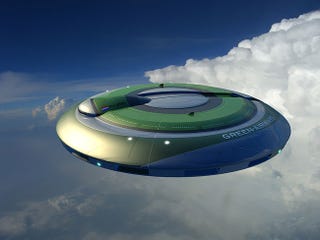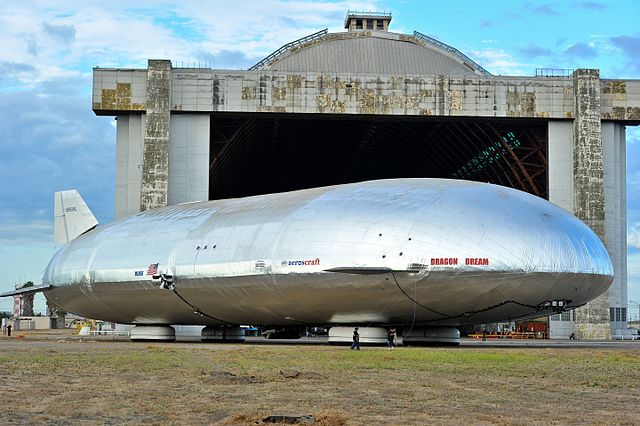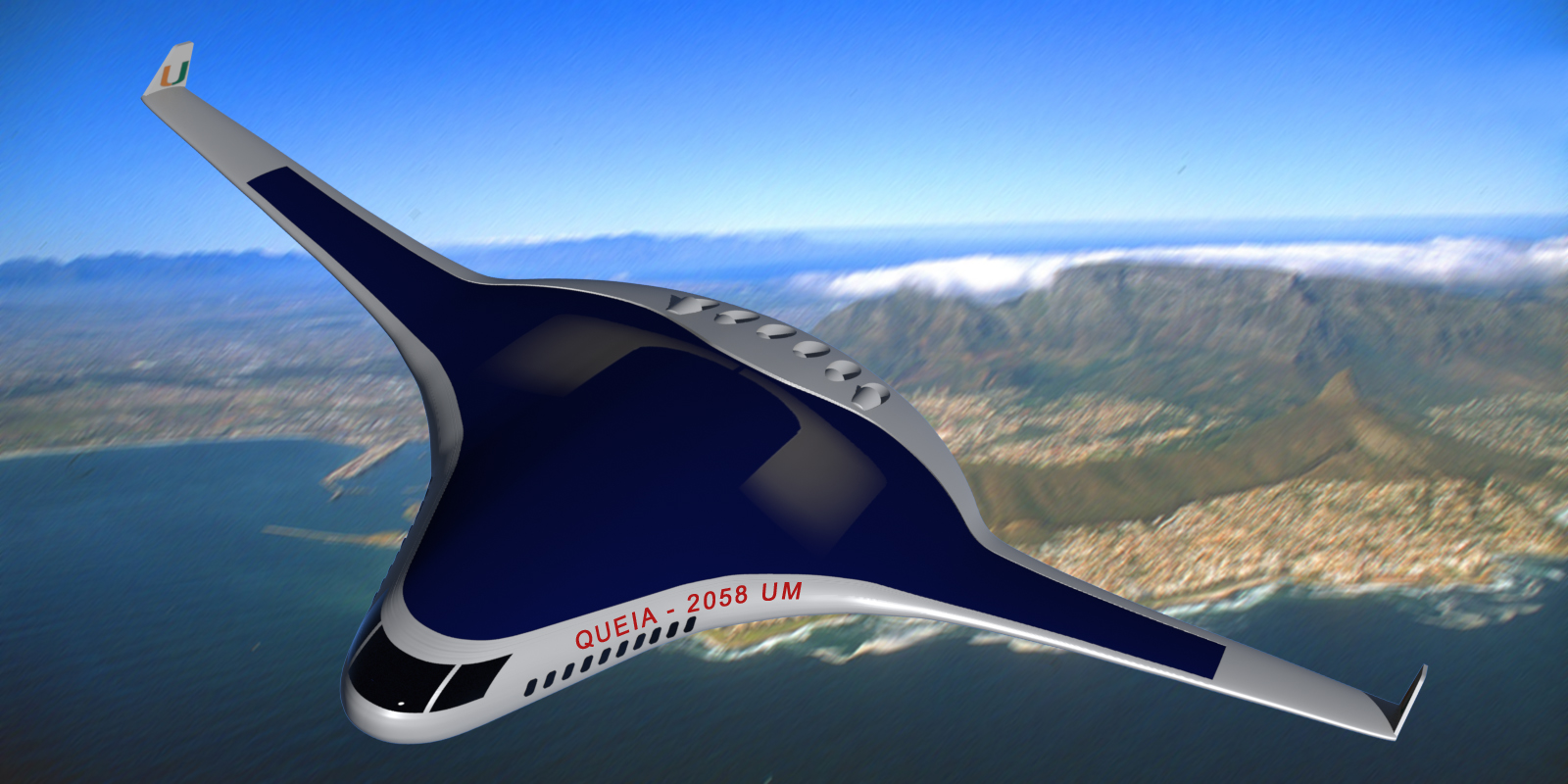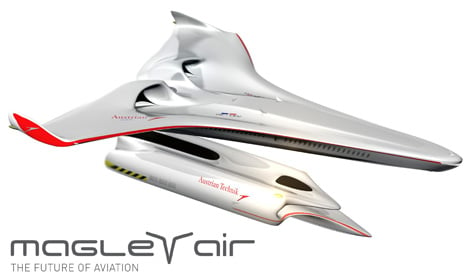There’s something almost romantic about the notion of futuristic technology. We live in an era where the technology of only a few years past is outdated by current advances, and yet we still have so much to look forward to. Barely a hundred years ago, the idea of manned flight was a dream shared among the collegiate fringe, and now we literally have a robot on Mars that can vaporize rocks with lasers.
Is it so far fetched to think that sometime in the near future we’ll be flying around on flying saucers, or taking day trips to space for vacation? The designers of these futuristic aircraft don’t think so. Some of these are simply design concepts; others are already past the test phase and slated for production; all of them are pretty incredible.
10. The Airbus Transparent Plane
Tentatively scheduled for completion in 2050, the Airbus Transparent Plane doesn’t look to change the mechanics of flight so much as the experience. The entire craft is transparent, which is probably terrifying to some people but, like skydiving, will end up being exhilarating instead (hopefully). Passengers check in by placing their palm on the transparent door which doubles as a biometric scanner, and the seats will automorph to conform to your body shape.
The seats will also be designed to absorb body heat from the passengers, which will then be converted to help power the plane, making this the only time a fear of flying will actually help prevent a crash. Finally, see-through ceilings let you recline and “live the panorama in which you are flying,” according to Charles Champion, the head of engineering for Airbus. You can see his entire presentation in the video below.
9. The Green-Airways Flying Saucer

The flying saucer, the paragon of science fiction, is something that none of us probably expect to see within our lifetimes, but that doesn’t stop aerospace engineers from conceptualizing ways in which we could build them at some point. Etnel Straatsma, who works at the Delft University of Technology, is experimenting with new ways of building aircraft that are more eco-friendly—with the aim to ideally cut carbon emissions by 50%, when compared to typical commercial aircraft.
One of those potential designs has taken the form of the Green-Airways Flying Saucer, a concept that looks as futuristic as it sounds. Straatsma’s project is still on the drawing board, but Subrata Roy, an associate professor of aerospace engineering at the University of Florida, claims to have a working model that will be ready sometime in 2013. Yes, a working model of a flying saucer. It runs by using electrodes across its surface to ionize the air around it, which pulls negative electrons out of the atmospheric gases to create plasma. It maneuvers by leveraging the disparate pressure between plasma and air to create positive or negative influence, essentially providing thrust. But don’t take our word for it; the link above will blow your mind.
8. The Skylon Surface-To-Orbit Plane

Current spacecraft follows a now-recognizable format: Massive thrusters are used for takeoff, which are then cast away. Smaller engines take their place, as the ship reaches the lower gravity of the outer atmosphere. It works, but it’s not very efficient, to say the least. This is why research has been turning towards SSTO RLVs, or “single-stage-to-orbit reusable launch vehicles” – spacecraft that resemble typical aircraft more than the bulky shuttle design we’ve been using for so long.
Enter the Skylon, an SSTO RLV that will have a shelf life of over 200 launches – and reentries – which is just about ready to be manufactured. The design for the aircraft, which receives 90% of its funding from private corporations, will use a single multi-purpose engine for both stages of flight. In the atmosphere, it will pull oxygen from the air like a jet engine and, in the vacuum of space, it will switch to an onboard fuel supply, a design that saves space, weight (a big deal with spacecraft), and money.
7. The X-51A Waverider, Capable of Sustained Mach 6 Speeds
To make another historical comparison, passengers crossing the Atlantic on steamships in the early 20th century could look forward to at least 3 days on board the ship. Current airliners make the trip in about 7 or 8 hours. And then there’s the X-51A Waverider, which can feasibly go from one side of the Atlantic to the other in a little less than an hour. Developed by Boeing, the X-51 can travel at Mach 6, which equates to about 4,000 mph. It recently set the record for sustained flight over Mach 5, or five times the speed of sound.
The Waverider can hold sustained flight at hypersonic, or Mach 5+, speeds for at least 300 seconds, which is enough to send this plane (or any missiles developed from its technology) to anywhere within a 450-mile radius, in about the time it took you to read this entry.
So far the Waverider, so named because it actually rides on its own shockwaves, has undergone three official tests, with mostly successful flights that invariably ended by crashlanding in the Pacific.
6. The Aeroscraft Dirigible Airship

Not since the Hindenberg explosion of 1937 has the world payed any real attention to airships, but they seem to be making a comeback as we look for more fuel-efficient, and eco-friendly, means of travel, this time without hydrogen. The leading candidate right now is the Aeroscraft Dirigible Airship, which is being developed by the Worldwide Aeros Corporation. The airship weighs 400 tons, and is just over an acre in total size. Its buoyancy comes from a combination of helium and jet engines which are used during takeoff and landing.
It also uses an internal ballast system to maintain bouyancy, whenever supplies are loaded or removed. In a typical blimp or airship, the cargo acts as part of the ballast system, so when you drop something off, the ship is instantly lighter and can shoot up off the ground. The Aeroscraft uses compressed helium in combination with its downward facing jets to stabilize it no matter what else is happening with the onboard weight
While the Aeroscraft has definite uses for public transportation or carrying supplies, the company is mainly interested in contracting with the Pentagon for purposes of surveillance (#7). With the right equipment, the Aeroscraft could simply hover over any area for days, and provide surveillance for ground activity.
5. The QUEIA 2058 Concept Craft

Aerodynamics as we know it could get a makeover with the QUEIA 2058, a conceptual aircraft designed by students at the University of Miami for the 2008 NASA Aeronautics Contest. The QUEIA, which stands for “Quiet Ultra-Efficient Integrated Aircraft,” is a proposed look at what a plane might look like in 2058. It does away with the tail, which is typically used for stability, and uses engines that are contained within the frame of the craft.
What’s revolutionary about it is that there are no moving parts. One thing most airplanes have in common is that they use small flaps on the backside of the wings, called ailerons, to control the plane’s roll. Lift the flap on one wing, and that side of the plane drops in response to increased air pressure on its surface. The QUEIA design does away with that, in favor of a more efficient design, since moving parts typically decrease the longevity of a machine.
While this particular design might never make it off the drawing board, the student team that created it is looking forward to a promising future in aeronautics, and one team member was given an internship at the NASA Research Center in Langley, Virginia.
4. The MagLev Air Urban Transport

This is another design that’s still in the conceptual stage, but it already shows a lot of promise for short-distance urban travel. The MagLev Air, designed by the three man team of Georg Milde, Denis Ors, and Leonie Lawniczak, is a combination plane and shuttle system, that could be used to launch small aircraft via a magnetic acceleration shuttle.
The shuttle runs on a grounded rail, and accelerates quickly enough to launch a small jet into the air, much like an aircraft carrier’s launch system, or the motion your hand makes as you throw a paper airplane. Once in the air, the MagLev uses scram jets for thrust. The system could be used in urban envirnoments for quick travel between two places, or as a shuttle between connecting airports. It’s suited for this because the magnetic launch system reduces noise pollution
3. Lockheed Martin’s SkyTug Hybrid Airship

This is a hybrid airship developed by Lockheed Martin that, like the Aerocraft, will be able to take off vertically and then use rear-facing propellers to provide thrust. What’s unique about it is that it’s designed aerodynamically to provide extra lift when it’s moving forward, much like a plane’s wing. Wings are designed with a curve on the top so that as air flows past them, it has to move faster on top and in doing so creates less air pressure above the wing than below it, essentially pushing the wing up. The SkyTug, and its precursor, the P-791, use that same principle, only applied over their entire bulbous frame.
Another unique point about the SkyTug is that, on the ground, it can hover on a cushion of air and move around without ever touching the surface (like a hovercraft,) allowing it to “land” on rocky or dangerous terrain, or even water.
2. The DARPA/Boeing DiscRotor

DARPA seems to be in the background of everything involving technology these days, and air travel is no exception. While the other entries here involve fixed-wing craft or airships, this one is closer to a futuristic helicopter. The DiskRotor, developed by DARPA and Boeing, will take off and land with the use of rotating blades, just like a helicopter. Once in the air, however, the blades will contract into a large disk on top of the craft, and jet engines on the sides will propel it forward, using the disk itself as the wings.
This hybrid design will allow vertical take off and landing, but also give it the capability for high speed air travel, which helicopters can’t normally achieve.
1. The Icon A5
As incredible as it is to imagine the future possibilities of air travel, there’s a good chance some of the examples on this list won’t make it into production. So here’s a futuristic aircraft that we’ll likely see in mass production by mid-2013: The Icon A5, an amphibious two person plane with folding wings and a cockpit that looks like nothing more than the interior of an SUV.
This plane is clearly marketed as a toy for the wealthy and, with a price tag of $139,000, it’s actually cheaper than a Porsche 911 Turbo (although parachutes cost extra). If anything, this is the likely evolutionary direction of the mythical flying car that science fiction has promised us for years. With a few wheels the A5 could conceivably land on a road while the automatic wings fold up on its back, and all you have to do is coast it into your garage.
7 Comments
Bane thats really true
As usual, BOOOOOOORRRRRRRIIINNNG!!! For petes sake, when will mankind produce an engineer with some vision?
If any one who reads this thinks for a minute that even one of these concepts will become reality, I have a bridge to sell you. The most laughable one is the statement “scheduled for completion in 2050”. No company in the history of the planet ever projected that far ahead, most have problems looking four years into the future. I’d love to see a rendering of an aircraft thought up in 1976 for delivery in 2013. I’m sure it would have been just as futuristic with transporter beams and robot flight attendants.
If you want an example of what the industry projected and the actual reality, look no further than the development of the A380 eight years ago when Airbus predicted casino’s and cafes that passengers would stroll around to. Instead of all that, we got high density seating for 550.
I read the Russians, where there is much water and marsh, were working in a really wide body, passengers sit across rather than in aisles, a lifting body propelled from the rear with side winglets, able to land on water without pontoons, carry like 10 or so into aquatic areas. I thought, seeing the patent, will see one online soon.
i call “BS” on #10. Not because it’s not possible, but because of past history. Commercial airline makers like airbus and boeing have a long history of talking up what “COULD” be done with future planes, but when push comes to shove the airlines go for the far more boring and predictable features that make them more money. An on board fitness area on the A380, or a shopping arcade? nah, let’s cram as many cattle class seats as we can in the extra space and get a better profit margin! So yeah, a see thru plane would seem cool, but they’ll likely be more looking for a way to squeeze that last penny from each flight instead.
Well the A5 is here. \o/
Number 9 looks like a robot vacuum cleaner.